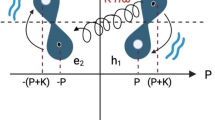Abstract
We designed a retroviral computer, of which hardware is composed of DNA/RNA dependent DNA polymerase, transcriptase, RNaseH, and DNA and RNA strands. Sequences of DNA strands define functions and RNA single strands work as arguments and return values for each function. In this paper, we show that computational jobs, such as encoding of input data and AND/OR operation, can work on this computer. By combining multiple functions, more complex molecular programs for gene analysis can be constructed. Experimental study showed that some functions were actually executed in vitro autonomously. Since this computer has originally derived from the retrovirus mechanism, we expect an in vivo computer will be realized from this technology, which detects the cell state through gene expression patterns, and controls the cell conditions with output RNA. It may provide a powerful tool for both research and clinical application.
Access this chapter
Tax calculation will be finalised at checkout
Purchases are for personal use only
Preview
Unable to display preview. Download preview PDF.
Similar content being viewed by others
References
Adleman, L.M.: Molecular computation of solutions to combinatorial problems. Science 266, 1021–1024 (1994)
Lipton, R.J.: DNA solution of hard computational problems. Science 268, 542–545 (1995)
Braich, R.S., Chelyapov, N., Johnson, C., Rothemund, P.W., Adleman, L.: Solution ofa 20-variable 3-SAT problem on a DNA computer. Science 296, 499–502 (2002)
Nakajima, T., Sakai, Y., Suyama, A.: Solving a 10-variable 43-clause instance of 3-SAT problems on DNA computer automatically executing a basic instruction set. In: Preliminary Proc. of The Eighth International Meeting on DNA Based Computers, p. 332 (2002)
Suyama, A., Nishida, N., Kurata, K., Omagari, K.: Gene expression analysis by DNA computing. In: Miyano, S., Shamir, R., Takagi, T. (eds.) Currents in Computational Molecular Biology, pp. 12–13. Universal Academy Press, Inc., Tokyo (2000)
Nishida, N., Wakui, M., Tokunaga, K., Suyama, A.: Highly specific and quantitative gene expression profiling based on DNA computing. Genome Informatics 12, 259–260 (2001)
Mills Jr., A.P.: Gene expression profiling diagnosis through DNA molecularcomputation. Trends Biotechnol. 20, 137–140 (2002)
Morimoto, N., Kiyohara, H., Sugimura, N., Karaki, S., Nakajima, T., Makino, T., Nishida, N., Suyama, A.: Automated processing system for gene expression profiling based on DNA computing technologies. In: Preliminary Proc. of The Eighth International Meeting on DNA Based Computers, p. 331 (2002)
Normile, D.: DNA-based computer takes aim at genes. Science 295, 951 (2002)
Benenson, Y., Paz-Elizur, T., Adar, R., Keinan, E., Livneh, Z., Shapiro, E.: Programmable and autonomous computing machine made of biomolecules. Nature 414, 430–434 (2001)
Guatelli, J.C., Whitfield, K.M., Kwoh, D.Y., Barringer, K.J., Richman, D.D., Gingeras, T.R.: Isothermal, in vitro amplification of nucleic acids by a multienzyme reaction modeled after retroviral replication. Proc. Natl. Acad. Sci. USA. 87, 1874–1878 (1990)
Ehricht, R., Kirner, T., Ellinger, T., Foerster, P., McCaskill, J.S.: Monitoring the amplification of CATCH, a 3SR based cooperatively coupled isothermal amplification system, by fluorimetric methods. Nucleic Acids Res. 25, 4697–4699 (1997)
Yoshida, H., Suyama, A.: Solution to 3-SAT by breadth first search. DIMACS Series in Discrete Mathematics and Theoretical Computer Science. American Mathematical Society 54, 9–22 (2000)
Wakui, M., Yamaguchi, A., Sakurai, D., Ogasawara, K., Yokochi, T., Tsuchiya, N., Ikeda, Y., Tokunaga, K.: Genes highly expressed in the early phase of murine graft-versus-host reaction. Biochem. Biophys. Res. Commun. 282, 200–206 (2001)
Author information
Authors and Affiliations
Editor information
Editors and Affiliations
Rights and permissions
Copyright information
© 2004 Springer-Verlag Berlin Heidelberg
About this paper
Cite this paper
Nitta, N., Suyama, A. (2004). Autonomous Biomolecular Computer Modeled after Retroviral Replication. In: Chen, J., Reif, J. (eds) DNA Computing. DNA 2003. Lecture Notes in Computer Science, vol 2943. Springer, Berlin, Heidelberg. https://doi.org/10.1007/978-3-540-24628-2_20
Download citation
DOI: https://doi.org/10.1007/978-3-540-24628-2_20
Publisher Name: Springer, Berlin, Heidelberg
Print ISBN: 978-3-540-20930-0
Online ISBN: 978-3-540-24628-2
eBook Packages: Springer Book Archive




